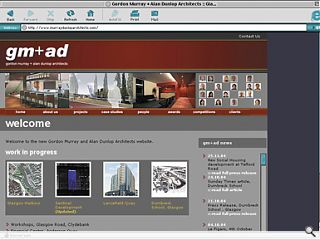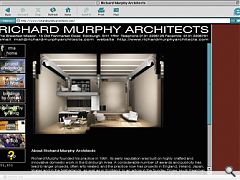Ask yourself not what your website can do for you, but what you can do for your website.
17 Dec 2004
In the age of the internet, it is astonishing to still find architects without a website. Clearly these practitioners have no desire to promote themselves or are cosy in the security of commissions gained on the golf course or via the Rotary Club. The next level of complacency is exhibited by those who are too mean to employ a specialist in the field and choose instead to design their practice website themselves. “Hand-knitted” would be too kind a term for this particular grouping, their graphic skills locked away somewhere in the 1960s, and the extent of their Web literacy cruelly exposed for all to see. How these dinosaurs expect to get work from the information revealed on their home pages (and there is usually only a home page) is anybody’s guess, but not a question they seem to ask themselves.
“To see ourselves as others see us” ought to be the maxim applied by every architect before going online, with some ruthless self-examination on the purpose of the website, the audience it aims to attract, and the information it will offer to ensure further contact is made and new work secured. Yes, it really is that simple – e-marketing and e-sales – but how many architects have addressed the development of their website from this perspective? Precious few is the answer, and a good book could be written on the mistakes made by architects seduced by their own graphic sensibility and the belief that this will separate them from the pack and bring the projects rolling in. Sorry, your design skills are not always the first thing on the mind of a potential client who may not, in any case, be able to distinguish between different architectural approaches to a given problem.
Researching material on architects’ work can be a frustrating experience if pursued through websites alone – so many fail to appreciate what a visitor might be looking for or the time they are likely to give over to finding it. Imagine for a moment an administrative minion tasked with putting together a list of practices capable of designing a new office building. With no personal experience of commissioning architects, he/she types a few keywords into Google and awaits the results. Ping! A list emerges of all those whose websites include the kind of details so beloved by Egan and Latham, and – with all the boxes properly ticked – the shortlist forms itself. For those not on it, a tip for the future – your company accounts, PII cover, Quality Assurance certificates, CVs, etc, may not seem graphically exciting, but they are what the commissioning visitor needs to be able to find – and quickly. There is not a snowball’s chance of them poring over the design intricacies of your most recently completed project if the information they want isn’t there.
All of this ought to be self-evident, but deluded architects everywhere continue to express astonishment at how projects have gone to someone else when they were so obviously much better suited and experienced. Obvious to whom, one wonders, because the information put out to the world doesn’t tell the same story. Vague waffle about being “client focused” just doesn’t cut the mustard and contrived descriptions of internal “quality assurance” systems should be quietly removed.
When it comes to online presence, ask yourself these simple questions about your site: would I buy a new building design on the evidence presented or is there enough information to convince me to inquire further? If the answer to both is no, either budget for a New Year website makeover or get a Golf Club application form.
by Peter Wilson
Read next: Princes Street
Back to December 2004
Browse Features Archive
Search
News
For more news from the industry visit our News section.
Features & Reports
For more information from the industry visit our Features & Reports section.




